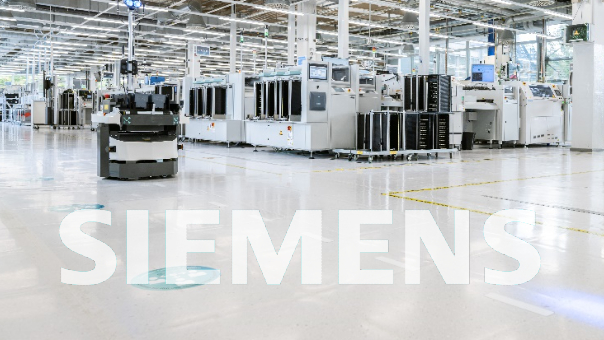This article is continued from a previous post, under the header, “The last word from Industry 4.0’s Mister 5G’; to read the intro-part, click here.
The explanation from Daniel Mai, replacing Sander Rotmensen as Mister 5G at Siemens, that the German firm’s new private network system is now in-trial with select customers, as an iterative test version of the final product ahead of its full release in the summer, suggests that Siemens’s approach remains cautious – even as the adjacent telco market grows excitable, near-hysterical, about its potential role in the Industry 4.0 saga.
Rotmensen, sitting alongside Mai at Hannover Messe, just prior to the handover and still in charge of the firm’s 5G narrative, reiterates that slow-moving industry will dictate the pace of its own digital revolution. “We want feedback, which is why we want this controlled rollout,” he says. Time is on its side, the argument goes – no matter what they say. Most of the market remains in-test, he says, and history will say Siemens was there at the start.
“It is a unique opportunity [to work with customers] with a new technology like this,” says Rotmensen. As a measure of the market’s progress, German regulator BNetzA told a panel session at RCR Live in London last week that it has so far issued 312 local enterprise licences for private networks in the 3.7-3.8 GHz band; its UK counterpart Ofcom said at the same event it has issued “just around 800-900 [network] licences” at 3.8-4.2 GHz. But most of these are proofs, argues Siemens.

Rotmensen comments: “The majority [in Germany] are pilots. We’re only really now starting to see the wheels hit the road with private 5G. So the timing is exactly right. We waited for the right technology to be available to offer something which is capable of supporting small and medium enterprises, as well as large enterprises. And combined with the fact that it is industrialised, and tailor-made for OT, I think we have a rough diamond here.”
It is worth noting how much work has gone in – “from core network to radio access network” – for Siemens to build a bespoke system from scratch, even despite its juggernaut resources. “It is a full-blown system, but it is not a telco system for telcos engineers. We’ve created something from that world to fit into our world. Which means all kinds of things – like it runs 24/7, from minus-30 to plus-60 degrees, which can be managed by OT operators.”
As some kind of context; Siemens took “building blocks” from the telecoms market, says Rotmensen, and developed them for Industry 4.0 users, and ultimately made them its own (“owned now by us,” he says). The core network, plus dashboard and user interface, are Siemens-made, the message goes; the industrial PCs running the core network are manufactured at home, at its plant in Karlsruhe – which is also live-testing the Siemens system.
The RAN units are by an unnamed third-party ODM brand “in the first phase”– on the grounds they are quicker to bring to market (and “we don’t want to be slow”); but Siemens will bring their production home to Karlsruhe in 2024. “And then we will have a hardware solution that is entirely German-made,” says Rotmensen. “And so, again, on that other question, I think we’re right on time,” he adds – just in case there is any doubt.
He explains: “It’s a couple boxes; you plug them in, pick the settings, and you’re away. And it is open – because OT does not want a black box in the factory, which it can’t diagnose or fix if something goes wrong. You can’t turn to the CEO, and say, ‘I don’t know’. You want to see the fault in the dashboard, and reconfigure or replace – even if you have to call an expert. Production can’t just stop because you can’t see inside the system.”
The implication is that the rest of the supplier market, which has been merrily hawking private 4G and 5G for some years, is making enterprises hostages-to-fortune with black-box service plans. But the charge list is longer; it implies these others are offering less-than-suitable Industry 4.0 systems, which are either too complex and unwieldy for OT technicians, or too lightweight and flaky for their hostile work settings – or both, and more.
Rotmensen is not about to comment on competitors; when presented with a rather-fudged question about HPE’s tie-up with Athonet, and its line about closer Wi-Fi coexistence (which echoes the message from Volkswagen at Hannover Messe about the need for Wi-Fi like authorisation and authentication for shop-floor 5G systems), he swerves to say, again, that Siemens’ primary concern is its legacy OT base in manufacturing.
“What is very clear is that we are focused on industrial verticals. We have seen traction in all kinds of sectors, and maybe we’re even a little surprised at the breadth of interest. Because, if you look back at wireless LAN, it was clearly adopted by discrete manufacturing, first, and was less well received in process automation. But [process manufacturing] is one of the front runners in this. Which is something we’re really excited about.”
It turns out Siemens has not, as imagined, been running 5G proofs in its own factories with rival gear. “Not that I’m aware of,” responds Rotmensen, when asked. Have you not? I thought you were. “Not in our factories.” So do your customers, then, testing competitor systems in their own production silos in Germany, say these other products do not make the grade? I mean, you were on stage with Volkswagen, and it said as much.
Are your customers saying the same? “Well, Volkswagen is one of our customers – and I heard it on stage, like you did,” responds Rotmensen. “But the general view is that customers want the right technology. For us, it doesn’t matter who deploys it. We will work with anyone – telecoms operators, system integrators. All the local SIs have private 5G offerings now. And it would be great if they went with a technology that was developed for this market. But it is up to them.”
All of which begs a heap more questions; we will catch up with Rotmensen and Mai again next week.
To be continued…

